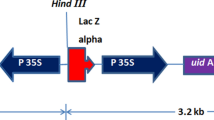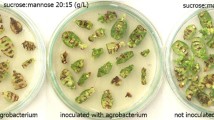Abstract
In order to improve the efficiency of cassava (Manihot esculenta Crantz) transformation, two different selection systems were assessed, a positive one based on the use of mannose as the selective agent, and a negative one based on hygromycin resistance encoded by an intron-containing hph gene. Transgenic plants selected on mannose or hygromycin were regenerated for the first time from embryogenic suspensions cocultivated with Agrobacterium. After the initial selection using mannose and hygromycin, 82.6% and 100% of the respective developing embryogenic callus lines were transgenic. A system allowing plant regeneration from only transgenic lines was designed by combining chemical selection with histochemical GUS assays. In total, 12 morphologically normal transgenic plant lines were produced, five using mannose and seven using hygromycin. The stable integration of the transgenes into the nuclear genome was verified using PCR and Southern analysis. RT-PCR and northern analyses confirmed the transgene expression in the regenerated plants. A rooting test on mannose containing medium was developed as an alternative to GUS assays in order to eliminate escapes from the positive selection system. Our results show that transgenic cassava plants can be obtained by using either antibiotic resistance genes that are not expressed in the micro-organisms or an antibiotic-free positive selection system.
Similar content being viewed by others
References
Deblaere R, Bytebier B, De Greve H, Deboeck F, Schell J, Van Montagu M and Leemans J (1985) Efficient octopine Ti plasmid-derived vectors for Agrobacterium-mediated gene transfer to plants. Nucl Acids Res 13: 4774–4778.
Eckes P, Rosahl S, Schell J and Willmitzer L (1986) Isolation and characterisation of a light-inducible, organ-specific gene from potato and its expression after tagging and transfer into tobacco and potato shoots. Mol Gen Genet 199: 216–224.
Ferber D (1999) GM crops in the cross hairs. Science 286: 1662–1666.
Ferguson JD, Street HE and David SB (1958) The carbohydrate nutrition of tomato roots. IV. The inhibition of excised root growth by galactose and mannose and its reversal by dextrose and xylose. Ann Bot 22: 525–538.
González AE, Schöpke C, Taylor NJ, Beachy RN and Fauquet CM (1998) Regeneration of transgenic cassava plants (Manihot esculenta Crantz) through Agrobacterium-mediated transformation of embryogenic suspension cultures. Plant Cell Rep 17: 827–831.
Grant JE, Cooper PA, Gilpin BJ, Hoglund SJ, Reader JK, Pither-Joyce MD and Timmerman-Vaughan GM (1998) Kanamycin is effective for selecting transformed peas. Plant Sci 139: 159–164.
Gresshoff P and Doy C (1974) Derivation of a haploid cell line from Vitis vinifera and the importance of the stage of meiotic development of the anthers for haploid culture of this and other genera. Z Pflanzenphys 73: 132–141.
Haldrup A, Petersen SG and Okkels FT (1998a) Positive selection: a plant selection principle based on xylose isomerase, an enzyme used in the food industry. Plant Cell Rep 18: 76–81.
Haldrup A, Petersen SG and Okkels FT (1998b) The xylose isomerase gene from Thermoanaerobacterium thermosulfurogenes allows effective selection of transgenic plant cells using D-xylose as the selection agent. Plant Mol Biol 37: 287–296.
Hoekema A, Hirsch PR, Hoykaas P and Schilperoort R (1983) A binary plant vector strategy based on a separation of vir-and the T-region of the Agrobacterium tumefaciens Ti-plasmid. Nature 303: 179–180.
Holtorf S, Apel K and Bohlmann H (1995) Comparison of different constitutive and inducible promoters for the overexpression of transgenes in Arabidopsis thaliana. Plant Mol Biol 29: 637–646.
Jefferson RA (1987) Assaying chimeric genes in plants: the GUS gene fusion system. Plant Mol Biol Rep 5: 387–405.
Joersbo M, Donaldson I, Kreiberg K, Guldager Petersen S, Brunstedt J and Okkels FT (1998) Analysis of mannose selection used for transformation of sugar beet. Mol Breed 4: 111–117.
Joersbo M, Petersen SG and Okkels FT (1999) Parameters interacting with mannose selection employed for the production of transgenic sugar beet. Physiol Plant 105: 109–116.
Keinonen-Mettälä K, Pappinen A and von Weissenberg K (1998) Comparisons of the efficiency of some promoters in silver birch (Betula pendula). Plant Cell Rep 17: 356–361.
Li H-Q, Sautter C, Potrykus I and Puonti-Kaerlas J (1996) Genetic transformation of cassava (Manihot Esculenta Crantz) Nature Biotech 14: 736–740.
Li H-Q, Huang YW, Liang CY, Guo JY, Liu HX, Potrykus I and Puonti-Kaerlas J (1998) Regeneration of cassava plants via shoot organogenesis. Plant Cell Rep 17: 410–414.
Malca I, Endo RM and Long MR (1967) Mechanism of glucose counteraction of inhibition of root elongation by galactose, mannose, and glucosamine. Phyopathol 57: 272–278.
Mattanovich D, Rueker F, da Camara Machado A, Laimer M, Regner F, Steinkeller H, Himmler G and Katinger H (1989) Efficient transformation of Agrobacterium spp. by electroporation. Nucl Acids Res 17: 6747–6752.
Munyikwa TRI, Raemakers KCJM, Schreuder M, Kok R, Schippers M, Jacobsen E and Visser RGF (1998) Pinpointing towards improved transformation and regeneration of cassava (Manihot esculenta Crantz). Plant Sci 135: 87–101.
Murashige T and Skoog F (1962) A revised medium for rapid growth and bioassays with tobacco tissue cultures. Physiol Plant 15: 473–497.
Puite KJ and Schaart JG (1996) Genetic modification of the commercial apple cultivar Gala, Golden Delicious and Elstar via an Agrobacterium tumefaciens-mediated transformation method. Plant Sci 119: 125–133.
Puonti-Kaerlas J (1998) Cassava biotechnology. In: Tombs MP (ed.) Biotechnology and Genetic Engineering Reviews. Vol. 15 (pp. 329–364) Intercept, Andover, Hants, UK.
Puonti-Kaerlas J, Li H-Q, Sautter C and Potrykus I (1997) Production of transgenic cassava (Manihot esculenta Crantz) via organogenesis and Agrobacterium-mediated transformation. African J Root Tuber Crops 2: 181–186.
Raemakers CJJM, Sofiari E, Taylor N, Henshaw G, Jacobsen E and Visser RGF (1996) Production of transgenic cassava (Manihot esculenta Crantz) plants by particle bombardment using luciferase activity as selection marker. Mol Breed 2: 339–349.
Sambrook J, Fritsch EF and Maniatis T (1989) Molecular Cloning: a laboratory manual. CSH Laboratory Press, Cold Spring Harbor, NY.
Schenk RU and Hildebrandt AC (1972) Medium and techniques for induction and growth of monocotyledonous and dicotyledonous plant cell cultures. Can J Bot 50: 199–204.
Schöpke C, Taylor N, Carcamo R, Konan NK, Marmey P, Henshaw GG, Beachy RN and Fauquet C (1996) Regeneration of transgenic cassava plants (Manihot esculenta Crantz) from microbombarded embryogenic suspension cultures. Nature Biotech 14: 731–735.
Schöpke C, Carcamo R, Beachy RN and Fauquet C (1997) Plant regeneration from transgenic and nontransgenic embryogenic suspension cultures of cassava (Manihot esculenta Crantz). African J Root Tuber Crops 2: 194–195.
Soni R and Murray JAH (1994) Isolation of intact DNA and RNA from plant tissues. Anal Biochem 218: 474–476.
Taylor NJ, Edwards M, Kiernan RJ, Davey CDM, Blakesley D and Henshaw GG (1996) Development of friable embryogenic callus and embryogenic suspension culture systems in cassava (Manihot esculenta Crantz). Nature Biotech 14: 726–730.
Vancanneyt G, Schmidt R, O'Connor-Sanchez A, Willmitzer L and Rocha-Sosa M (1990) Construction of an intron-containing marker gene-splicing of the intron in transgenic plants and its use in monitoring early events in Agrobacterium-mediated plant transformation. Mol Gen Genet 220: 245–250.
Wang MB, Upadhaya NM, Brettell RIS and Waterhouse PM (1997) Intron-mediated improvement of a selectable marker gene for plant transformation using Agrobacterium tumefaciens. J Genet Breed 51: 325–334.
Withers LA (1985) Cryopreservation and storage of germplasm. In: Dixon RA (ed.) Plant Cell Culture: A Practical Approach (pp. 169–191) IRL Press, Oxford.
Zhang P, Legris G, Coulin P and Puonti-Kaerlas J (in press) Production of stably transformed cassava plants via particle bombardment. Plant Cell Rep.
Zhang P and Puonti-Kaerlas J (in press) PIG-mediated cassava transformation using positive and negative selection. Plant Cell Rep.
Author information
Authors and Affiliations
Rights and permissions
About this article
Cite this article
Zhang, P., Potrykus, I. & Puonti-Kaerlas, J. Efficient Production of Transgenic Cassava Using Negative and Positive Selection. Transgenic Res 9, 405–415 (2000). https://doi.org/10.1023/A:1026509017142
Issue Date:
DOI: https://doi.org/10.1023/A:1026509017142




